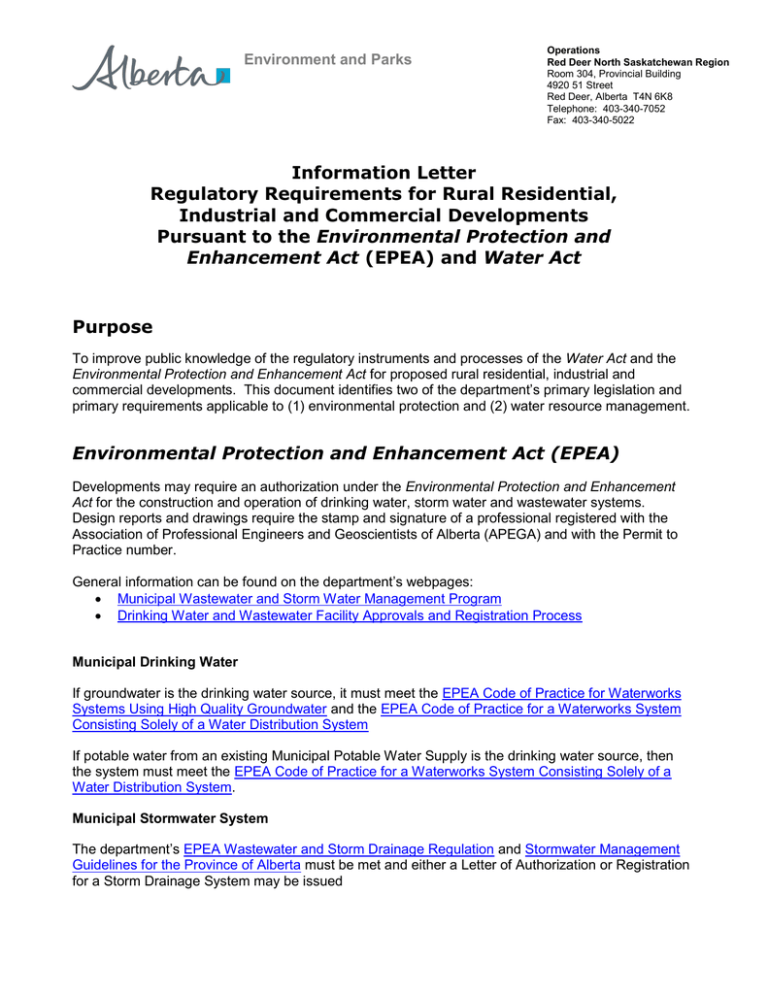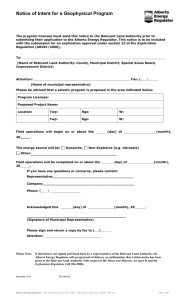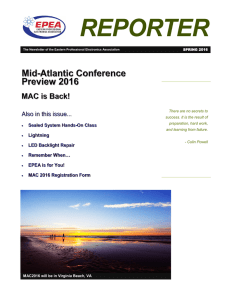Information Letter Regulatory Requirements for Rural Residential
advertisement

Environment and Parks Operations Red Deer North Saskatchewan Region Room 304, Provincial Building 4920 51 Street Red Deer, Alberta T4N 6K8 Telephone: 403-340-7052 Fax: 403-340-5022 Information Letter Regulatory Requirements for Rural Residential, Industrial and Commercial Developments Pursuant to the Environmental Protection and Enhancement Act (EPEA) and Water Act Purpose To improve public knowledge of the regulatory instruments and processes of the Water Act and the Environmental Protection and Enhancement Act for proposed rural residential, industrial and commercial developments. This document identifies two of the department’s primary legislation and primary requirements applicable to (1) environmental protection and (2) water resource management. Environmental Protection and Enhancement Act (EPEA) Developments may require an authorization under the Environmental Protection and Enhancement Act for the construction and operation of drinking water, storm water and wastewater systems. Design reports and drawings require the stamp and signature of a professional registered with the Association of Professional Engineers and Geoscientists of Alberta (APEGA) and with the Permit to Practice number. General information can be found on the department’s webpages: Municipal Wastewater and Storm Water Management Program Drinking Water and Wastewater Facility Approvals and Registration Process Municipal Drinking Water If groundwater is the drinking water source, it must meet the EPEA Code of Practice for Waterworks Systems Using High Quality Groundwater and the EPEA Code of Practice for a Waterworks System Consisting Solely of a Water Distribution System If potable water from an existing Municipal Potable Water Supply is the drinking water source, then the system must meet the EPEA Code of Practice for a Waterworks System Consisting Solely of a Water Distribution System. Municipal Stormwater System The department’s EPEA Wastewater and Storm Drainage Regulation and Stormwater Management Guidelines for the Province of Alberta must be met and either a Letter of Authorization or Registration for a Storm Drainage System may be issued Page 2 Municipal Wastewater Wastewater lagoon technology used to treat wastewater must meet the EPEA Code of Practice for Wastewater Systems Using a Wastewater Lagoon Packaged treatment systems with disposal of the wastewater by irrigation require a wastewater Approval and must meet our EPEA Guidelines for Municipal Wastewater Irrigation Municipal Sanitary Waste Municipal sanitary waste must be handled by landfill, in accordance with the EPEA Activities Designation Regulation and must meet our EPEA Standards for Landfills in Alberta Water Act Water Act Approvals and Licences are required for activity which impacts water bodies including aquifers, rivers, streams lakes, and wetlands. General information can be found on the department’s webpages: Water Management Activity Guidelines and Fact Sheets Water Act forms Proposed development within a floodplain may cause significant increases in flood water levels and lead to increased impacts on users located in the floodplain. Hydrologic and hydraulic studies carried out by a qualified professional may be required. The department’s Stepping Back from the Water Guide provides beneficial management practices for new development near water bodies to assist in minimizing the impacts and risks associated with development near water bodies and conserving riparian areas adjacent to rivers, streams, lakes, and wetlands. Design reports and drawings require the stamp and signature of a professional registered with the Association of Professional Engineers and Geoscientists of Alberta (APEGA) and with the Permit to Practice number. Drinking Water If groundwater is the drinking water source, a licence may be required and must meet the Water Act Guide to Groundwater Authorization 2011 and the EPEA Code of Practice for Waterworks Systems Using High Quality Groundwater Stormwater Management System The department’s Stormwater Management Guidelines for the Province of Alberta must be met by either an Approval and/or the Water Act Code of Practice for Outfall Structures on Water Bodies. The following two documents provide specific guidance: Policy number 6.0 of Municipal Policies and Procedures Manual April 2001 Standards and Guidelines for Municipal Waterworks, Wastewater and Storm Drainage Systems: Part 5 Stormwater Management Guidelines March 2013 Page 3 Impacts to Wetlands The goal of the Alberta Wetland Policy 2013 is to conserve, restore, protect and manage Alberta’s wetlands to sustain the benefits they provide to the environment, society and economy. To achieve this goal, wetlands are managed by avoiding and minimizing adverse effects, and, where necessary, replacing permanent loss of wetland area. Under the Alberta Wetland Policy Implementation process, a proposed activity that may impact a wetland consists of three stages: 1. Planning and Legislative Alignment 2. Wetland Assessment 3. Application Submission Applicable to all three stages are the Wetland Mitigation Hierarchy and the Qualified Wetland Science Practitioner (QWSP) Program. Activities that may impact a wetland, must follow these Directives which are located on our Alberta Wetland Policy Implementation webpage: Wetland Identification and Delineation Directive Wetland Assessment and Impact Report Directive Wetland Mitigation Directive Application Process The overall application process for both EPEA and the Water Act is: 1: Application Submission The completed and signed application form, together with supporting information is received by the Regulatory Approvals Centre (RAC) (address is on the application form). The application is forwarded to the appropriate district office by RAC. The amount of supporting information required depends on the scale and purpose of the application. 2: Administrative Review The administrative review verifies that all required information is included with the application. If required information is missing or additional information is needed, the applicant is notified by the appropriate district office and the application process is put on hold until all required information is received. Water Act licence fees may be required at this step. 3: Public Notice and First Nations Consultation When required by the department, the applicant will receive instructions to carry out public notice and/or First Nations consultation. The type of public notice and/or First Nations consultation required depends on the scale, location and purpose of the application. Environmental Protection and Enhancement Act registrations and Water Act Codes of Practice notices are not subject to public notice. Page 4 3.1. Public Notice Public notice provides an opportunity for those directly affected by the applicant’s application submission to submit Statements of Concern (SOC). The applicant must conduct the required public notice and respond to those who submitted a valid SOC in writing. SOCs must be submitted within 7 days of the public notice for an Approval and 30 days for a Licence. However, the Director may specify a longer period. Required public consultation/review must be completed and SOCs dealt with to the satisfaction of the Director before the next step in the application process is conducted. If the application is for a Water Act Licence Renewal or Transfer of Water under a Licence, public review may also be required. 3.2. First Nations Consultation The Crown’s duty to consult with First Nations is required where land management and resource development have the potential to adversely impact First Nations’ Rights and Traditional Uses. Alberta’s First Nations consultation process is carried out by the following policy and guideline: Government of Alberta’s Policy on Consultation with First Nations on Land and Natural Resource Management, 2013 Government of Alberta’s Guidelines on Consultation with First Nations on Land and Natural Resource Management, July 28, 2014. 4: Technical Review The technical review considers the management of water in the region and the protection of the aquatic environment, in addition to the requirements defined in the Water Act and the Water (Ministerial) Regulations. At this stage all of the information provided at each of the previous steps is reviewed and assessed to determine if the issuance of an authorization can be recommended. If required information is missing or additional information is needed, the applicant is notified by the appropriate district office and the application process is put on hold until all required information is received. 5: Designated Director Decision The Designated Director, under the Acts, renders a statutory decision as to whether an authorization can be issued or not and notifies the applicant and those who filed valid statements of concern of the decision. The applicant or SOC filers may appeal this decision as defined in the Acts. NOTE: Other legislation may also be relevant to the development. The onus is on the applicant to ensure compliance with all relevant legislation before proceeding with a development. February 2016



